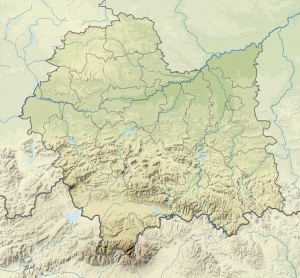Palace to the Four Winds
| Palace to the Four Winds | ||
|---|---|---|
|
Main facade |
||
| Creation time : | 1680 | |
| Castle type : | palace | |
| Conservation status: | Reconstructed | |
| Place: | Warsaw | |
| Geographical location | 52 ° 14 '49.7 " N , 21 ° 0' 14.6" E | |
|
|
||

The Palace of the Four Winds (also called Tepper Palace , Dückert Palace or Tepper-Dückert Palace , Polish: Pałac pod czterema wiatrami or Pałac Teppera-Dückerta ) is located in Warsaw on Ulica Długa 38/40 . It is located opposite the former Hotel Polski and around 100 meters from the Potkański Palace . The Polish headquarters of the World Health Organization are located here alongside other authorities .
history
The builder of the palace was Stanisław Kleinpolt, who after elevation to the nobility in 1676 called the name Stanisław Małopolski and with the construction of the building around 1680 created a residence befitting his rank. The design probably came from Tylman van Gameren . Jan Dobrogost Krasiński bought the property as early as 1685. Krasiński sold the palace to Bishop Andrzej Stanisław Załuski in 1698 .
18th century
Franciszek Ossoliński had been the owner since the 1730s; subsequently the owner changed frequently. After Jan Tarło and the magnate Michał Kazimierz Radziwiłł, the banker Piotr de Riacour lived here and from 1765 Piotr Tepper, from whom the palace passed to Piotr Fergusson Tepper in 1784 . Around the middle of the 18th century, Johann Sigmund Deybel redesigned the central projections of the building and added Rococo decorations to the other parts of the building . From 1769 to 1771, Simon Gottlieb Zug partially rebuilt the building. In the process, the right wing was enlarged and given an early classical facade. Presumably the two pavilions at the wing ends facing the street were also erected under Zug. Around 1784, Zug then redesigned the interior, creating a large, semicircular dining room on the first floor.
Around the same time, four sculptures of the brothers Notus , Boreas , Zephyrus and Eurus - after which the palace bears its name of the four winds - were erected above the entrance gate . The artist who performed these works is unknown.
"Hôtel de Dresde"
In 1801 the merchant Karol Fryderyk Dückert took over the palace at auction. It remained in the possession of his heirs until 1891. From 1808 the elegant "Hôtel de Dresde" was located in the building. In the ensemble's park, which was laid out by Zug, there was a building for the Institute for Artificial Mineral Water (Polish: Instytut Wód Mineralnych Sztucznych ) from 1824 to 1875 . From 1832 until their move to the Tarnowski Palace in 1856, the headquarters of Nowa Resursa Kupiecka was located in the representative rooms on the first floor , after this association had split off from the older Warszawska Resursa Kupiecka .
After the end of the First World War , the property was converted into a rental house and no longer maintained. In 1927, the Polish state acquired the building and had it renovated into the headquarters of the Ministry of Labor and Social Welfare .
In 1944 the palace was destroyed during the Warsaw Uprising . Between 1949 and 1951 it was rebuilt under Władysław Borawski in the 18th century state. Since then, various authorities have been located here, such as departments of the Ministry of Health and Social Welfare (Polish: Ministerstwo Zdrowia i Opieki Społecznej ), the Association of Polish Spas and the State Publishing House for Medical Literature .
today
In addition to the WHO, the building is currently used by the State Hygiene Office (Polish: Główny Inspektorat Sanitarny ) and parts of the Polish Ministry of Health (Polish: Ministerstwo Zdrowia ).
The baroque building, which has late baroque and classicist features, has three floors (the third floor is in the mansard roof ) and consists of the central building and two wings attached at right angles, which end in pavilions facing the street. The central risalit is crowned by a triangular gable with ornamental decorations and three busts in the Roman style. A plaque in memory of Marian Klott , the head of the labor inspectorate in the interwar period , was placed on the facade of the palace .
References and comments
- ↑ Stanisław Kleinpolt or Małopolski was a royal secretary, secretary and standard- bearer
- ^ Jan Dobrogost Krasiński (* 1639) was a Polish officer, Starost and trainee lawyer at the Crown
- ↑ Michał Kazimierz Radziwiłł (1702–1762) was a Polish-Lithuanian landowner and ordinate
- ↑ Piotr de Riacour, also Pierre or Peter de Riacour (1691–1768) was a banker and chamber councilor from the Electoral Saxony
- ^ Piotr Fergusson Tepper (1713–1794) was a Polish banker and entrepreneur of German origin
- ↑ Karol Fryderyk Dückert (Karl Friedrich Dückert, around 1764-1834) was a German-born banker and merchant in Warsaw
- ↑ Władysław Borawski (1892–1970, according to article Rozwiązanie sierpniowej odsłony quizu "Czy znasz to Śródmieście?" ( Page no longer available , search in web archives ) Info: The link was automatically marked as defective. Please check the link according to the instructions and remove it then this note. on the website of the Warsaw inner city district referred to as Ludwik Borawski) was a Polish architect and civil engineer who mainly built hospitals
literature
- Julius A. Chroscicki and Andrzej Rottermund, Architectural Atlas of Warsaw , 1st edition, Arkady, Warsaw 1978, p. 60
- Discover Małgorzata Danecka, Thorsten Hoppe, Warsaw. Tours through the Polish capital , Trescher Verlag, ISBN 978-3-89794-116-8 , Berlin 2008, p. 123
- Tadeusz S. Jaroszewski, Palaces and Residences in Warsaw , Interpress Publishing House, ISBN 83-223-2049-3 , Warsaw 1985, p. 105 f.
Web links
- History at Warszawa1939.pl (in Polish)



